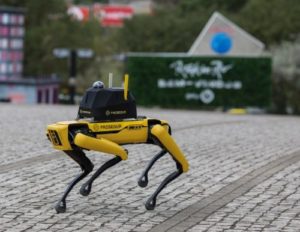
Prosegur, a global security solutions provider, has announced a new quadrupedal security robot equipped with facial recognition technology.
Characterized by the company as a “robot dog named Yellow”, the robot is designed to conduct security patrols, and is equipped with machine learning capabilities that Prosegur says allow it to adapt to any terrain. What’s more, it can build a map of a given patrol area over time.
Its computer vision capabilities allow it to distinguish known individuals from potential security threats, while other sensors enable it to detect changes in temperature and gas levels, allowing it to potentially flag fires or leaks. Upon detecting a security threat, the robot can flag it to human supervisors using 5G communications technology.
“By leveraging our GenzAI platform, state-of-the-art machine learning, communication, smart cameras and video analytics, Yellow can detect security threats, relay information to the [Security Operations Center] and on-site security to quickly respond and neutralize any danger,” explained Prosegur Chief Technology Officer Mike Dunn.
The robot is built on Prosegur’s GenzAI platform using software from the Azena marketplace.
The use of autonomous robots in security applications is of growing interest to a number of organizations, including the United States military. The US Space Force, for example, has been testing the use of quadrupedal robots to patrol the Cape Canaveral Space Force Station; and the Department of Homeland Security has been exploring the use of such robots to patrol the southern border, citing the robots’ resilience in harsh environmental conditions.
And at last year’s US Army trade show, Ghost Robotics showcased a quadrupedal robot equipped with a sniper rifle, calling it the “future of unmanned weapon systems.” In addition to offering greater resistance to environmental conditions, robot “dogs” lack the human emotions that can sometimes come into play on a battlefield.
Yellow, of course, is not equipped with a gun. The robot is designed only to detect security threats, and, unlike real dogs, it cannot be distracted by a strategically deployed treat.
–
August 30, 2022 – by Alex Perala







Follow Us